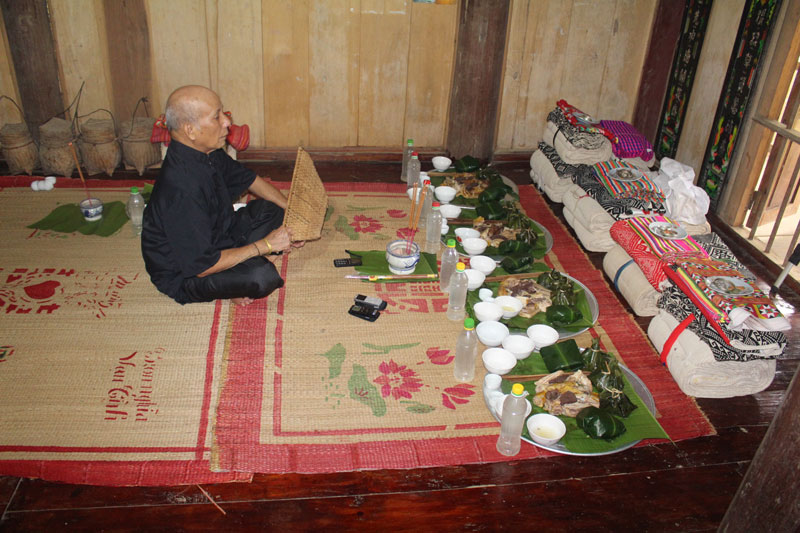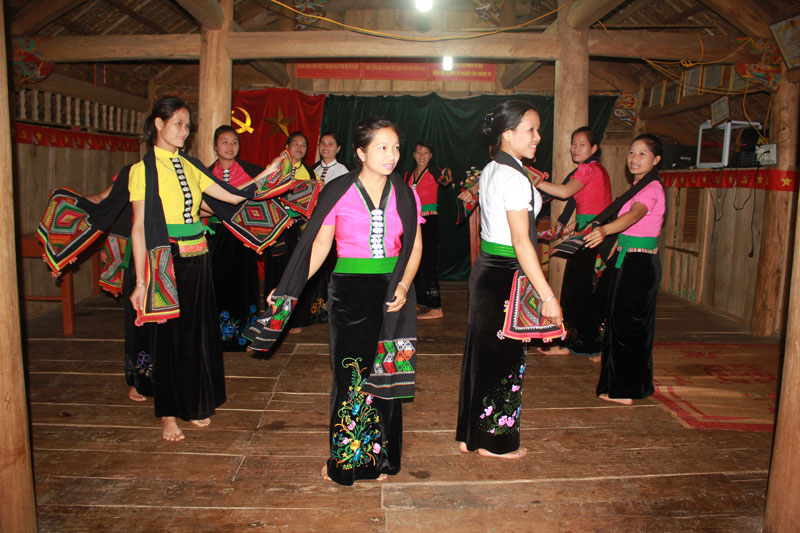
(HBO) – Tay ethnic people account for 40.57 percent of the population in Da Bac district, which is home to five ethnic groups. They reside in the communes of Muong Chieng, Dong Chum, Tan Pheo, Tan Minh and Trung Thanh.
We felt the atmosphere of the National Day when
returning to Muong Chieng, which has the biggest number of
Tayethnics and is described as the "mountainous centre” of Da Bac district. The
National Day September 2 was an occasion for those living far away to reunite
with their families. Sa Van Xuyen, a resident in Na Muoi hamlet, said: "My
family has three children, including two daughters working here and a son
working in
Son La.All of them have their own families. My son, Hung, and his wife have to live
far away because Hung has his own work while his wife is studying at
Tay
Bac
University. Only on the
occasion of major festivals my whole family reunite. My wife and I are waiting
to see them on the upcoming National Day or Independence Festival.”

Xa Van
Bang, a resident in Chieng Can hamlet of Muong Chieng commune (Da Bac), often
hold a ritual called "Lam cham” for his family according to Tay people’s
traditional custom after the Independence Festival celebration.
Bidding farewell to Xuyen, we came to Chieng Can
commune to visit Xa Van Hoi, who was a driver in the southern battlefield for
13 years (from 1970 to 1983). Recalling wartime memories, Hoi said: "The 13
years I was a driver at Unit 670 of Regiment 19 were also 13 times I spent the National
Day with my comrades and witnessed both pains and victories in the war. I still
remember the feeling of concurrently celebrating Tet (the traditional New Year
festival), standing guard and being ready to fight. It was not rare that I saw
my comrades were killed by the enemy’s bullets and bombs. Those pains nurtured
our undaunted and unyielding will, helping us fight for national independence.”
The team
of Na Man hamlet, Muong Chieng commune (Da Bac), rehearses a singing and
dancing performance imbued with the
Tayculture before the celebration of the National Day September 2.
His children usually come home twice a year, on
the National Day (September 2) and the Lunar New Year. Hoi said: "Whenever the
Independence Festival comes, I’m eager for my children to come back to reunite
with the family. To me, seeing my children gradually growing up each time we
gather is the most joyful festival.”
Singing and dancing performances and sports
activities like volleyball and football matches between hamlets, and communes
on the occasion of the Independence Festival were always magnets for local
residents.
We also witnessed
Tayethnic girls’ dedication to a rehearsal before their public performance marking
the National Day in Na Man hamlet of Muong Chieng commune. Xa Thi Thay, who led
the hamlet’s performing team, said they were rehearsing a "xoe” dance which
would be performed together with other teams in the commune. We chose this
dance since it was deeply imbued with the
Tayethnic group’s cultural identities, showing the community’s solidarity and
love.
Aside from entertainment activities, the "Lam
cham” ritual of
Tay people was also practiced
by many families in the Independence Festival. Xa Van Bang, a resident in
Chieng Can commune, said the ritual was often organised in the eighth or ninth
lunar months, but now some families hold this ritual on the September 2
occasion, when their whole families reunited.
The Department of Education and Training of Hoa Binh province held a conference on March 18 to review the performance of the "Safe and Happy School" Project and set out tasks for 2025. The project, funded by the Taiwan Fund for Children and Families (TFCF), aims to create a safe, inclusive, and supportive learning environment for students. The event saw the attendance of representatives from the TFCF and 26 beneficiary schools.
With over 70% of their workers being women, trade unions across industrial parks (IPs) in Hoa Binh have been actively safeguarding their legal rights and interests while implementing initiatives to improve their income and well-being.
In recent years, the Hoa Binh provincial General Hospital has continuously innovated itself and improved the quality of medical services to meet the increasing needs of local people. With substantial investments in infrastructure and modern equipment, along with a team of highly qualified doctors and nurses, the hospital has gradually established itself as one of the leading medical units in the Northwestern region and a trusted destination for healthcare for people inside and outside the province.
From mastering the fundamentals of programming to achieving national recognition, the Programming Club of the Le Van Tam Primary School (STAR LVT28) in Hoa Binh city has made remarkable strides in the field of robotics.
The Ho Chi Minh Communist Youth Union Committee and the Vietnam Youth Federation chapter of Hoa Binh province organised a programme on March 12 to launch the "Digital Literacy" movement and an online quiz on the resolutions of the Vietnam Youth Federation congresses at all levels, as well as the Politburo's Resolution No. 57-NQ/TW on breakthroughs in the development of science, technology, innovation, and national digital transformation.
As climate change grows more unpredictable, the development of production forests has become essential - not just for economic growth, but for safeguarding the environment and maintaining ecosystem balance. By boosting local incomes, curbing natural disasters, preventing soil erosion, and protecting water resources, these forests play a crucial role in sustainable development.




